
Get a new and permanent smile!

Hear Charlene's story of how she received a flawless smile with the All-on-Four™ Dental Implant System!
Get FREE information!

Dental Implants - Which one is right for me?
Single Missing Tooth - Are you missing just ONE tooth?
Figure 1.1
Here are your options:
A Removable Partial Denture is the first solution for replacing a missing tooth. Partial Dentures are meant to cover the place of a missing tooth with a fake one. The denture itself consists of a wire mesh with an acrylic coating (See Figure 1.1). This solution doesn't prevent loss of bone as it provides no bone stimulation (For information on bone resorption go to: Dental Implants. Another disadvantage to a partial denture is that food will often get stuck in the space between the denture and the hard palate which means that regular removal of the denture will be necessary in order to clean it.
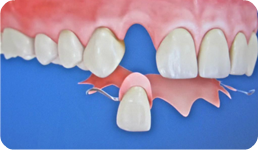
Figure 1.2
Tooth-supported fixed bridges are the next solution to a single missing tooth. Bridges are a row of posthetic teeth that are fixed on top of the two teeth adjacent to the missing tooth. In order for the fixed bridge to look natural over top of the adjacent teeth, part of the adjacent teeth are removed to make way for the bridge. The result is a stunning permanent tooth replacement. The disadvantage is that fixed bridges also don't provide adequate bone stimulation. Without proper bone stimulation, the gap where the tooth used to be shrinks and exposes the bridge. See the effect here: Dental Bone Resorption
An Implant-supported Crown is the final and most effective solution to single missing teeth. Implant Crowns consist of the embedding of a dental implant, similar to a screw, into the jaw bone followed by adding an abutment (See figure 1.3) and finally a crown on top. The results produce the look, feel, and function of a real tooth. The greatest advantage of implant supported crowns is that the dental implant provides adequate bone stimulation to prevent facial structure loss. This is because the implant behaves like a natural tooth root as it is embeded into the bone.
Several Missing Teeth - Are you missing TWO or more teeth?
Here are your options:
A partial denture is a low-cost and removable solution to several missing teeth. A partial denture, as described above, is a mesh-like metal frame or acrylic with teeth fused within it (See Figure 2.1). Partial dentures are a great temporary replacement but they are not the best looking. Often, partial dentures show unsightly metal pieces from the mesh frame. Partials also don't provide the proper bone stimulation need to stop the deterioration of the jaw bone. The remaining teeth often twist and move out of their natural position.
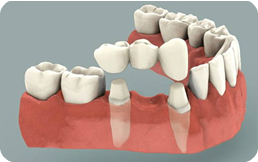
Figure 1.3
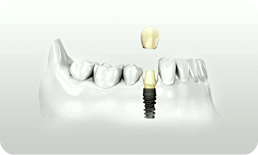
Figure 2.1
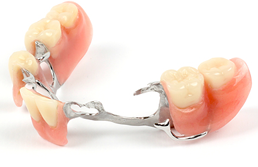
Figure 2.2
Once again, a tooth-supported fixed bridge is great solution for a single or several missing teeth. In the case of several missing teeth a fixed bridge includes a set of 4 teeth (See figure 2.2). As with the single tooth bridge, the adjacent teeth need to be shaved down so that the bridge can be placed. A disadvantage to this method of tooth replacement is that it still doesn't provide the proper bone stimulation to keep the jaw bone from deteriorating. The bridge looks good for a while but when as the jaw bone loses more mass the gums are revealed from under the bridge as the bridge pulls away from the gums.
Lastly, an implant-supported fixed bridge is best solution to replacing two or more missing teeth. An implant bridge is similar to a tooth-supported bridge except that the bridge rests on two dental implants that are grafted into the jaw bone (See figure 2.3). This is the best option of teeth replacements because dental implants always provide bone stimulation because they act like a natural tooth root. With this replacement option your smile will continue to look stunning after years and years of use because the structural integrity of your jaw will remain the same.
All Missing Teeth - Are you missing ALL of your teeth?
Here are your options:
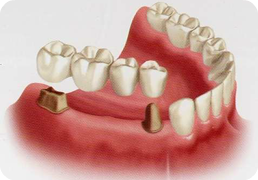
Figure 2.3
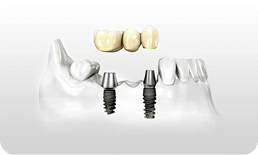
A complete upper and lower denture is the most common solution for all missing teeth. For years upon years people have been using dentures. One of the main issues with dentures is that they're not completely reliable when eating food and sometimes prevents you from being able to eat all the food you want. Another problem, more importantly, is that dentures don't stimulate the jaw bone enough to keep it from degrading.
An overdenture or an implant supported denture is the next solution for patients that are missing all of their teeth. Implant-supported dentures are not to be confused with the All-on-Four™ treatment. These dentures are placed on two tissue supported metal nobs (See Figure 3.2). The result is a high esthetic quality and a very natural look. This is the most cost effective tooth replacement treatment and has a great value. Overdentures are extremely stable and prevent lifting or floating of the denture which allows you to eat what you want. A disadvantage of overdentures is that they still need to be removed regularly to be cleaned and the jaw bone will also degrade where there is no tissue implant.
The All-on-Four™ Dental Implant Treatment
This option for permanent tooth replacement is one of the leading treatments when it comes to dental implants. The All-on-Four™ treatment provides you with the feel and function of real teeth where you are able to use toothpaste and a toothbrush just like a natural set of teeth. Dental professionals don't consider all-on-fours dentures so you can say goodbye to dentures and literally embrace a new set of teeth. Bone resorption is no longer a problem as the dental implants provide the adequate stimulation to prevent bone loss.
Figure 3.1 - Regular Dentures
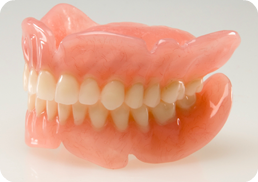
Figure 3.2 - Overdentures
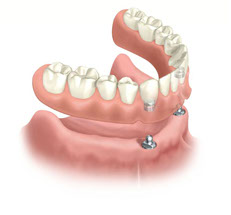
The All-on-Four™ Dental Implant System
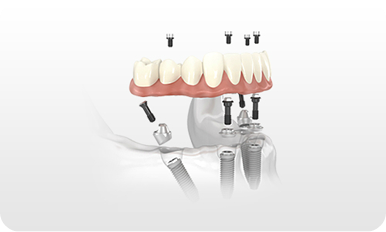
Key Features
Permanent and stunning teeth that feel and function like the real thing.
You don't take them out of your mouth, you brush and clean them like real teeth.
They are meant to last. All-on-Four™ dental implants are for a lifetime.
No more plastic on the roof of your mouth.